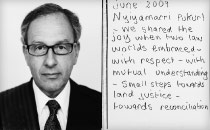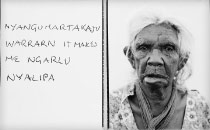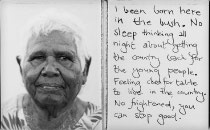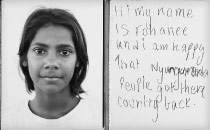Country
at the core of culture
View the photographs-
 Ada Stewart comments on the Nyangumarta native title determinations
Ada Stewart comments on the Nyangumarta native title determinations
-
 Rainer Mora Mathews comments on the Nyangumarta native title determinations
Rainer Mora Mathews comments on the Nyangumarta native title determinations
-
 Justice Anthony North comments on the Nyangumarta native title determinations
Justice Anthony North comments on the Nyangumarta native title determinations
-
 Alma Gray comments on the Nyangumarta native title determinations
Alma Gray comments on the Nyangumarta native title determinations
-
 Winnie Coppin comments on the Nyangumarta native title determinations
Winnie Coppin comments on the Nyangumarta native title determinations
-
 Rohanee Walters comments on the Nyangumarta native title determinations
Rohanee Walters comments on the Nyangumarta native title determinations
‘Connection to country and the ties we have to our land is as important to us today as it was to our ancestors.’
Nyaparu rose, Nyangumarta traditional owner
For Indigenous people, the land is more than soil, rocks or minerals; it is ‘country’—a place that sustains, and is sustained by, people and culture. At birth, people are associated with specific places that remain at the centre of all spiritual, social and economic wellbeing. The use of the term ‘country’ refers to this expanded idea of land.
Read more‘Country is a living entity with a yesterday, today and tomorrow, with a consciousness and a will toward life.’
Deborah Bird Rose, anthropologist

Native title holders lead Justice North to the site for the delivery of the Determination, Eighty Mile Beach (Nyiyamarri Pukurl) WA, 2009
Type C print
Nyiyamarri Pukurl, Western Australia
Photo Tobias TitzThe return of land to Indigenous people through native title claims is often a contentious issue. As defined by the National Native Title Tribunal, native title is the recognition by Australian law that some Indigenous people have rights to and interests in their land that come from their traditional laws and customs.
Negotiations between Indigenous community leaders and state and federal government, pastoralists, mining concerns and other land users can take many years, and often involve considerable tension.
Despite the difficulties, the formal recognition of Indigenous native title acknowledges the ongoing relationship Indigenous people have with the land. It also provides them with the opportunity to create sustainable, long-term benefits for their community, and to reaffirm their cultural identity and heritage.
‘Everything about aboriginal society is inextricably woven with, and connected to, land…you take that away and you take away our reason for existence.’
Professor Mick Dodson, former Aboriginal and Torres Strait Islander Justice Commissioner, Co-chair of Reconciliation Australia.
In 1992 the High Court handed down the Mabo Decision, which recognised the native title of the Meriam people from the Murray Islands in the Torres Strait. It was the first time the native title rights of Indigenous people were recognised at law. In response to this decision, the federal government passed the Native Title Act 1993 (Cth) which established a national system for the resolution of native title issues.
Two consent determinations by the Federal Court of Australia* recognised the Nyangumarta People’s native title over land in the Western Pilbara. This was celebrated at a hearing near Nyiyamarri Pukurl (Eighty Mile Beach) in June 2009. The consent determinations were made because all the parties reached an agreement about native title without going to court.
Tribunal member Mr Caitlin called the process exemplary: ‘This was a conflict-free mediation to the extent that it was conducted with the greatest harmony between the parties at all times.’
* Federal Court numbers WAD6281/1998 and WAD234/2007

